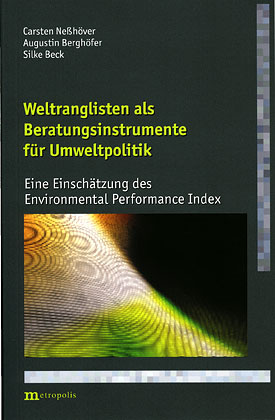Press release from February 28th, 2008
New Environmental Performance Index – not a model for Germany
Lumping different countries together – why the 2008 EPI is of limited use
Davos/Leipzig. For countries without their own environmental monitoring systems, the Environmental Performance Index (EPI) can be useful for working out where there is a need for action in environmental policy making. However, within the European Union there are more suitable instruments for this. This is one of the conclusions of a study conducted by the Helmholtz Centre for Environmental Research (UFZ). According to the study authors, Germany has more accurate and appropriate instruments than the 2008 EPI – such as the European Environment Agency’s State of the Environment Report and the Federal Environmental Agency’s Umweltbarometer.

The UFZ analysed the 2006 EPI on behalf of the Deutsche Bundesstiftung Umwelt and compared it with alternative evaluation systems in Germany. The study is available through the Metropolis publishing house (in German).
The EPI’s second edition was presented at the 2008 World Economic Forum in Davos, Switzerland. In the global 2008 EPI ranking, Germany is in 13th place and has moved up six places since the 2006 EPI. However, comparisons between the two EPI versions are not advisable because the 2008 EPI covers 25 indicators while its predecessor was based on 16 only.
The Helmholtz Centre for Environmental Research (UFZ) analysed the 2006 EPI on behalf of the Deutsche Bundesstiftung Umwelt and compared it with alternative evaluation systems in Germany. The authors of the UFZ study conclude that also the new version of the EPI is of limited use for orienting environmental policy making. Even though the 2008 EPI takes a more sophisticated approach than its predecessor, the new version still promotes one standardised assessment framework for all countries. However, environmental problems, their relative importance in national policy contexts and the political possibilities for dealing with them vary so much between continents and between regions that a single framework cannot be equally precise for all countries. This is true of the selection of indicators, the setting of target values and the weighting of individual aspects within the EPI.
For Augustin Berghöfer, one of the analysts at the UFZ, it comes as no surprise that many top places in the EPI ranking were taken by wealthy industrialised countries: "The high weighting that the EPI gives to issues of environmental health, favours all countries that have the financial means for a sound health system, adequate sanitation and safe drinking water. The sensitivity analysis in the EPI report shows that different indicator weightings produce entirely different country rankings." This somewhat questions the claim in the EPI press release of 23 January 2008 which states that ‘wealth is a major determinant of environmental success’.
Another difficulty is the legitimacy of the targets set for each indicator. The EPI employs a distance-to-target method which requires
explicit target values, against which the countries are measured. According to the EPI 2008 report, only 5 out of 25 target values have
been set in international agreements or guidelines, all others represent expert judgement taken from scientific literature. Berghöfer says,
"the EPI lacks crucial legitimacy as an instrument for benchmarking. Why should governments measure themselves against target values which
they may not even have heard of so far?" Nor do these target values visibly represent consensus within academia. Consider the State of the
Environment Report of the EEA as an alternative example: Target values are only used where agreed upon by all governments, and the EEA
scorecard was developed and agreed upon in a multi-year consultation process.
In general, the EPI can provide valuable information on the need for action in different environmental policy areas for countries that do
not have country specific monitoring systems. Within the European Union however, there are more legitimate and better adapted instruments
for this purpose.
On 23 January 2008 a consortium led by Yale University presented a new version of the EPI (the 2008 EPI) at the Davos World Economic Forum with the aim of quantifying past efforts and the current need for action in the area of environmental policy. Like its predecessor, the 2006 EPI, the index is designed to provide a basis for the evaluation of national environmental policies and to enable comparisons between the environmental policies of different countries.
Links:
The Pilot 2006 Environmental Performance Index:
Der Pilot 2006 Environmental Performance Index
Environmental Performance Index 2008 [BETA] of the Yale University:
Environmental Performance Index 2008
"Umweltbarometer" of the German UBA
Umweltbarometer of the UBA
"State of the Environment Report" of the EEA:
State of the Environment Report
Publication:
Carsten Neßhöver, Augustin Berghöfer, Silke Beck:
Weltranglisten als Bewertungsinstrumente der Umweltpolitik - Eine Einschätzung des Environmental Performance Index.
Metropolis-Verlag, Marburg.- 120 S.
Weltranglisten als Bewertungsinstrumente der Umweltpolitik
More information:
Dr. Carsten Neßhöver/ Augustin Berghöfer / Dr. Silke Beck
Helmholtz Centre for Environmental Research - UFZ
Tphone +49 341-235-1649, -1649 ,-1733
or
Helmholtz Centre for Environmental Research - UFZ
Press office
Tilo Arnhold / Doris Böhme
phone +49 341 235 2278
presse@ufz.de
The Helmholtz Centre for Environmental Research – UFZ was established in 1991 and has about 800 employees in Leipzig, Halle/S. and Magdeburg. They study the complex interactions between humans and the environment in cultivated and damaged landscapes. The scientists develop concepts and processes to help secure the natural foundations of human life for future generations.
The Helmholtz Association contributes to solving major challenges facing society, science and the economy with top scientific achievements in six research areas: Energy, Earth and Environment, Health, Key Technologies, Structure of Matter, Transport and Space. With 25,700 employees in 15 research centres and an annual budget of approximately 2.3 billion euro, the Helmholtz Association is Germany's largest scientific organisation. Its work follows in the tradition of the great natural scientist Hermann von Helmholtz (1821-1894).
